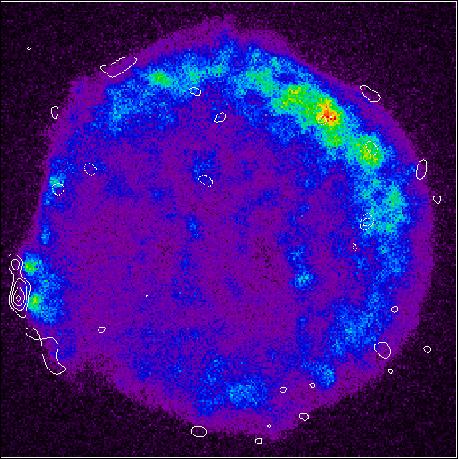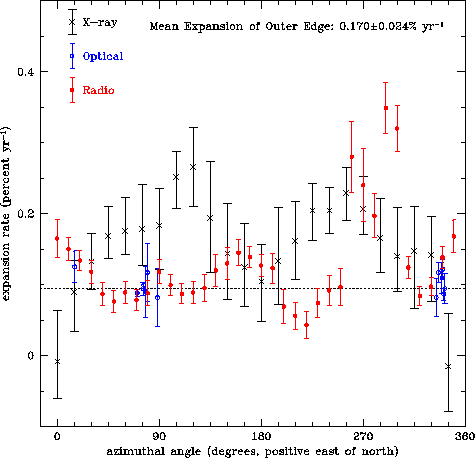
Figure 1.: Deep ROSAT HRI soft (0.2- 2 keV band) X-ray image of Tycho's SNR. Solid (dashed) contours show regions of increased (decreased) flux when this image is compared to one taken 4.5 years earlier. The contour levels are in units of
Figure 1 shows a 104 ks observation of Tycho taken by the HRI in February 1995. This image is about five times deeper than any previous high resolution X-ray image and it reveals interesting new features. Most notable is the weak rim of emission seen clearly around the entire remnant, which is believed to be the blast wave propagating through the surrounding circumstellar medium. The time baseline between this pointing and the first epoch one (done in July 1990) was about 4.5 years, roughly 1% of the SNR's age. A number of techniques were developed to estimate background (made difficult by the strong grain scattering halo from Tycho), generate exposure maps (including telescope vignetting and spatial variations of the HRI quantum efficiency), correct for aspect drift, and finally align the images. The contours on the image show small-scale-size regions where a significant change in X-ray flux has occurred in 4.5 years. Notice that the increased brightness regions (solid contours) are distributed around the periphery of the remnant, while the regions of dimming (dashed contours) appear further in. Simulations were used to assess the significance of these features and I find that most of the flux changes are real and represent evidence for expansion of Tycho's SNR.

Figure 1.: Deep ROSAT HRI soft (0.2- 2 keV band)
X-ray image of Tycho's SNR. Solid (dashed) contours show regions of
increased (decreased) flux when this image is compared to one taken
4.5 years earlier. The contour levels are in units of ![]() and
the ones shown correspond to values of -4, -3, 3, 4, 5, and 6.
and
the ones shown correspond to values of -4, -3, 3, 4, 5, and 6.
I determined the expansion rate by examining the count rates in
azimuthal sectors of a thin radial region at the edge of the remnant.
Quantitative results were obtained by shifting the first epoch image
along the direction of the center of each sector until the count rates
in the old and new images, from that azimuthal region, were the same.
The X-ray expansion rates as a function of azimuthal angle are shown
in Figure 2 along with radio and optical results for comparison.
Note that each azimuthal sector was ![]() wide, although we show
results for sectors with centers separated by
wide, although we show
results for sectors with centers separated by ![]() .
.

Figure 2.: Expansion of Tycho's SNR in the X-ray, optical, and radio
bands. The rate corresponding to the Sedov expansion law (n=0.4)
is shown as the horizontal dashed line. The X-ray points at
![]() and
and ![]() include the location of the bright
knots in the southeastern quadrant of Tycho. Note that these points
are consistent with undecelerated motion (a value of 0.24%
yr
include the location of the bright
knots in the southeastern quadrant of Tycho. Note that these points
are consistent with undecelerated motion (a value of 0.24%
yr ![]() ).
).
The azimuthally-averaged current expansion rate of the outermost rim
of the X-ray remnant is ![]()
![]() yr
yr ![]() (90%
confidence level errors). For a radial region that is slightly
interior to this but which still precedes the brightest ring of
emission, I find a slower expansion rate
(90%
confidence level errors). For a radial region that is slightly
interior to this but which still precedes the brightest ring of
emission, I find a slower expansion rate
![]()
![]() yr
yr ![]() . When the age, t of a
remnant is known, it is possible to express its expansion rate in
terms of
. When the age, t of a
remnant is known, it is possible to express its expansion rate in
terms of ![]() , where
, where ![]() is the angular
size. The mean radii of the selected radial regions in Tycho
are 248.9
is the angular
size. The mean radii of the selected radial regions in Tycho
are 248.9 ![]() and 238.2
and 238.2 ![]() so the expansion
rates are
so the expansion
rates are ![]() (outer edge) and
(outer edge) and ![]() (inner
edge). The radio data, as analyzed by Tan & Gull (1985), give an
average expansion rate of n=0.462. One possible explanation for the
difference with the X-ray results may be that the radio expansion was
obtained over the entire radial extent of the remnant. This would
tend to ``dilute'' the effect of the fastest moving material at the
outermost rim of the remnant.
(inner
edge). The radio data, as analyzed by Tan & Gull (1985), give an
average expansion rate of n=0.462. One possible explanation for the
difference with the X-ray results may be that the radio expansion was
obtained over the entire radial extent of the remnant. This would
tend to ``dilute'' the effect of the fastest moving material at the
outermost rim of the remnant.